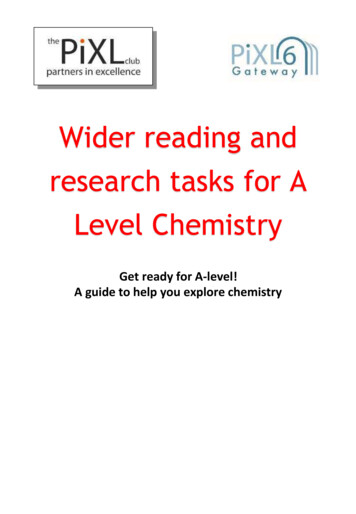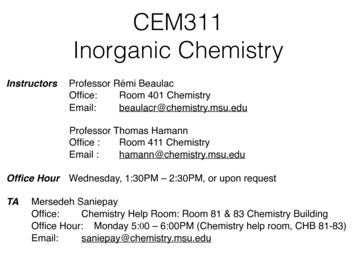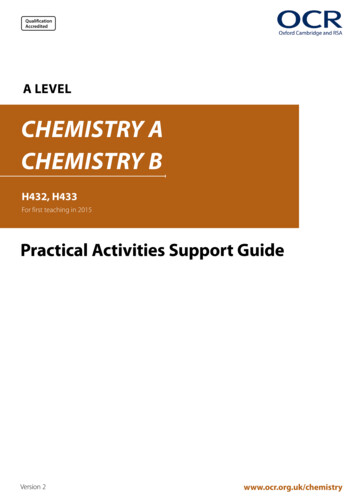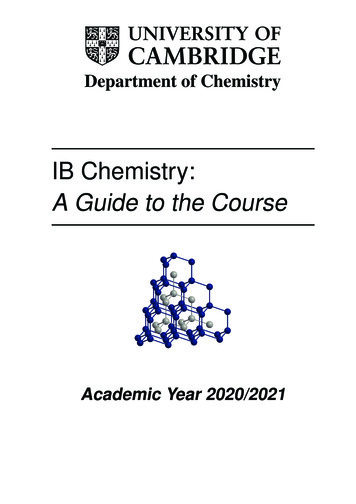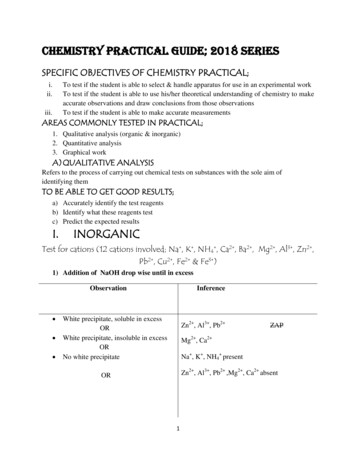
Transcription
CHEMISTRY PRACTICAL GUIDE; 2018 SERIESSPECIFIC OBJECTIVES OF CHEMISTRY PRACTICAL;i.ii.iii.To test if the student is able to select & handle apparatus for use in an experimental workTo test if the student is able to use his/her theoretical understanding of chemistry to makeaccurate observations and draw conclusions from those observationsTo test if the student is able to make accurate measurementsAREAS COMMONLY TESTED IN PRACTICAL;1. Qualitative analysis (organic & inorganic)2. Quantitative analysis3. Graphical workA) QUALITATIVE ANALYSISRefers to the process of carrying out chemical tests on substances with the sole aim ofidentifying themTO BE ABLE TO GET GOOD RESULTS;a) Accurately identify the test reagentsb) Identify what these reagents testc) Predict the expected resultsI.INORGANICTest for cations (12 cations involved; Na , K , NH4 , Ca2 , Ba2 , Mg2 , Al3 , Zn2 ,Pb2 , Cu2 , Fe2 & Fe3 )1) Addition of NaOH drop wise until in excessObservation InferenceWhite precipitate, soluble in excessORWhite precipitate, insoluble in excessORNo white precipitateZn2 , Al3 , Pb2 ZAPMg2 , Ca2 Na , K , NH4 presentZn2 , Al3 , Pb2 ,Mg2 , Ca2 absentOR1
Cu2 Blue precipitate, insoluble in excessORGreen precipitate, insoluble in excessORBrown precipitate, insoluble in excessFe2 Fe3 2) Addition of aq. Ammonia drop wise, until in excessObservation InferenceWhite precipitate, soluble in excessORWhite precipitate, insoluble in excessORNo white precipitate formedZn2 Al3 , Pb2 , Mg2 Na , K , Ca2 Zn2 , Al3 , Pb2 , Mg2 AbsentOR 2 Light blue precipitate, soluble in excess Cuto give a deep blue solutionORGreen precipitate, insoluble in excessFe2 ORFe3 Brown precipitate, insoluble in excess3) Dip a nichrome wire into the solution and burn in a non luminous flame (Flame testfor cations)Observation InferenceNa Burns with a yellow flameOR2
Ca2 Burns with a red flameORBurns with a purple flameK OR Burns with a white flameMg2 4) Addition of three drops of H2SO4/Na2SO4/K2SO4Observation InferenceCa2 , Ba2 , Pb2 White precipitate5) Addition three drops of HCl/NaCl/KClObservation InferencePb2 , Ag White precipitate6) Addition of two drops of potassium iodideObservation InferencePb2 Yellow precipitate3
TEST FOR ANIONS (SIX ANIONS; SO42-, SO32-, CO32-, Cl-, NO3- & HCO3-)1) Addition of two drops of barium nitrateObservation InferenceSO42-, SO32-, CO32-White precipitate2) Addition of two of drops of barium nitrate followed by five drops of nitric (V) acidObservationInference White precipitate, dissolvesaddition of nitric (V) acid Bubbles of colourless gas producedOR White precipitate, insolubleaddition of nitric (V) acid22upon SO3 , CO3upon SO42-3) Addition of two drops of acidified barium nitrateObservation InferenceSO42-White precipitate.4
4) Addition of three drops of lead (II) nitrateObservation InferenceSO42-, SO32-, CO32-, Cl-White precipitate.5) Addition of two drops of lead (II) nitrate followed by five drops of nitric (V) acidObservationInference 22White precipitate, soluble on addition SO3 , CO3of nitric (V) acid. Bubbles of colourless gasORWhite precipitate, insolubleaddition of nitric (V) acid upon SO42-, Cl-6) Addition of two drops of lead (II) nitrate, followed by wormingObservation White precipitate,wormingInferencesolubleupon ClOR White precipitate,worminginsolubleupon SO42-, SO32-, CO32-5
7) Addition of two drops of acidified lead (II) nitrateObservation InferenceSO42-, Cl-White precipitate8) Addition of two drops of acidified potassium dichromate (VI)Observation InferenceSO32Bubbles of colourless gas,Colour of H /K2Cr2O7 turns fromorange to greenOR Bubbles of colourless gasH /K2Cr2O7 retains its orange colourCO32-6
9) Take about ½ of the solid provided into a dry test tube and heat it gently thenstronglyObservation InferenceColourless liquid formed on uppercooler parts of the test tubeBlue litmus paper turns red and redlitmus paper remains redRed litmus paper turns blue & bluelitmus paper remains blueBubbles of colourless gas that blows ofa burning splintThe solid is hydrated Brown fumesNO3- Relights a glowing splintNO3- Residue white when cold & yellow ZnO formedwhen hot White solid formed on cooler parts of Contains a solid that sublimetest tube Acidic gas producedNH4 CO32-/HCO3-10) Put the solid into a boiling tube, add about 10ml of distilled water and shakeObservation InferenceThe solid is soluble in waterDissolves to form a colourless solutionCu2 , Fe2 , Fe3 absent7
11) Put the solid into a boiling tube, add water, shake then filterObservation InferencePartially dissolves to form a white The solid is a mixture of soluble and insolublesalts.residue and a Colourless filtrateCu2 , Fe2 , Fe3 absent both in the residue & inthe filtrate12) Transfer the residue from filter paper using a spatula into a boiling tube, addabout 2 ml of nitric (V) acidObservation InferenceSO32-, CO32-Bubbles of colourless gasThe solid dissolvesII. ORGANIC1) Put the solid in a metallic spatula and burn it in a Bunsen burner flameObservation InferenceMelts,Burns with a blue non sooty flameORMelts,Burns with a yellow/sooty flameC C / C C absentC C / C CNB; Melts is not a must to be observed, only ifit is observed8
2) Put 4 drops of the liquid on a watch glass and burn itObservation InferenceBurns with a blue non sooty flameC C / C C absent ORBurns with a yellow sooty flameC C / C C3) Put the liquid in a boiling tube, add water then shakeObservation InferencePolar organic compoundMiscible, forming uniform solution4) Put the solid into a boiling tube, add about 10 ml of distilled water and shakeObservation InferencePolar organic compoundDissolves to form a colourless solution5) Put the solid into a boiling tube, add ethanol & shakeObservation InferencePolar organic compoundDissolves to form a colourless liquid9
6) Determine the pH of the solution provided (Use of universal indicator)Observation InferenceWeakly acidicpH 6.5OR pH 7NeutralOR pH 2Strongly acidicOR pH 8Weakly alkalineOR Strongly alkalinepH 14NB; 4 to 6.5 is weakly acidic, 1 to 3 is stronglyacidic, 8 to 10 is weakly alkaline & 11 to 14 isstrongly alkaline. This will help you with otherpH values that have not been included underthe observation column7) Add 4 drops of acidified potassium manganate (VII)Observation InferencePurple potassium manganate (VII) isdecolorizedC C / C C , R-OH10
8) Add 4 drops of acidified potassium dichromate (VI)Observation InferenceR-OHPotassium dichromate (VI) turns fromorange to greenNB; used for testing for R-OH, not for doubleand triple bonds9) Addition of 4 drops of bromine waterObservation InferenceBromine water is decolorizedC C / C C10) Add the solid Na2CO3/NaHCO3 provided into the solutionObservation InferenceH /R-COOHBubbles of colourless gas produced11
CURRENT TRENDS IN SETTING1) (Compiled from Nyakach girls Chemistry contest 2018 edition)You are provided with;o Solid Q suspected to be Zinc Sulphateo 2 M Sodium hydroxide solutiono 2 M Aqueous ammoniao 2 M Nitric (V) acido 0.5 M Barium Chloride solutiono Distilled water(a) Using the provided chemicals, write down three tests and expected observations tocompletely confirm the identity of solid Q(i)Test 1Expected observation(s)Put solid Q into a boiling tube, add10 ml of distilled water, then shaketo dissolve solid Q. Divide the solutionformed into 3 portions; To the 1st portion,add sodium hydroxide drop wise until inexcess(ii)White precipitate, soluble in excessTest 2Expected observation(s)2ndTo theportion, add aqueousammonia drop wise until in excess(iii)White precipitate, soluble in excessTest 3Expected observation(s)To the 3rd portion, add two drops ofbarium chloride, followed by about10 ml of nitric (V) acidWhite precipitate formed upon addingbarium chloride, the white precipitatedo not dissolve when acid is added2) You are provided with;o Solid R suspected to be Aluminium Chlorideo 2 M Sodium hydroxide solutiono Sodium Carbonate solutiono 0.5 M Lead (II) nitrateo 0.2 M Barium Nitrateo Distilled water(b) Using the provided chemicals, write down four tests and expected observations tocompletely confirm the identity of solid R(i)Test 1Expected observation(s)Put solid R into a boiling tube, add10 ml of distilled water, then shaketo dissolve solid R. Divide the solutionformed into 4 portions; To the 1st portion,add sodium hydroxide drop wise until inexcessWhite precipitate, soluble in excess12
(ii)Test 2Expected observation(s)To the 2nd portion, add two drops ofSodium carbonate(iii)No white precipitate formedTest 3Expected observation(s)To the 3 portion, add two drops ofLead (II) nitrateWhite precipitate is formedrd(iv)Test 4Expected observation(s)To the 4th portion, add two drops ofbarium nitrateNo white precipitate is formed3) You are provided with;o Solid S suspected to be Zinc Sulphateo 2 M Aqueous ammoniao Lead (II) nitrate solutiono 2 M Nitric (V) acido Barium Nitrate solutiono Distilled water(a) Using the provided chemicals, write down three tests and expected observations tocompletely confirm the identity of solid S(i) Test 1Expected observation(s)Put solid S into a boiling tube, add10 ml of distilled water, then shaketo dissolve solid S. Divide the solutionformed into 3 portions; To the 1st portion,add aqueous ammonia drop wise until inexcess(ii)White precipitate, soluble in excessTest 2Expected observation(s)Add two drops of lead (II) nitrate(iii)White precipitateTest 3Expected observation(s)Add two drops of barium nitrate followedby about 10 ml of nitric (V) acidWhite precipitate, insoluble whenacid is added4) You are provided with;ooooooooSolid T suspected to be Lead (II) nitrate2 M Sodium hydroxide solutionSodium Chloride solutionAluminium foilRed and blue litmus papersDistilled waterTest tube holderSource of heat13
(a) Using the provided chemicals, write down three tests and expected observations tocompletely confirm the identity of solid T(i) Test 1Expected observation(s)Put solid T into a boiling tube, add10 ml of distilled water, then shaketo dissolve solid T. Divide the solutionformed into 3 portions; To the 1st portion,add sodium hydroxide drop wise until inexcess(ii)White precipitate, soluble in excessTest 2Expected observation(s)To the 2nd portion, add two dropsof sodium chloride(iii)White precipitate formedTest 3Expected observation(s)3rdTo theportion, add 6 drops ofNaOH, drop a piece of aluminiumfoil into the mixture then heat to boiland test any gas produced using litmus papersBubbles of colourless gas. Redlitmus paper turns blue and bluelitmus remains blue-NB; The theory behind test 3; aluminium foil reduces NO3to NH4 then NH4 formedreacts with NaOH to produce NH3 (KCSE 2012)5) You are provided with;o Solid U suspected to be Magnesium Sulphateo 2 M Sodium hydroxide solutiono 2 M Aqueous ammoniao 0.5 M Barium Nitrate solutiono 2 M Nitric (V) acido Distilled water(a) Using the provided chemicals, write down three tests and expected observations tocompletely confirm the identity of solid U(i) Test 1Expected observation(s)Put solid U into a boiling tube, add10 ml of distilled water, then shaketo dissolve solid U. Divide the solutionformed into 3 portions; To the 1st portion,add sodium hydroxide drop wise until inexcess(ii)White precipitate, insoluble in excessTest 2Expected observation(s)To the 2nd portion, add aqueousammonia drop wise until in excessWhite precipitate, insoluble in excess14
(iii)Test 3Expected observation(s)To the 3rd portion, add 2 drops of bariumnitrate followed by addition of about10 ml of nitric (V) acidWhite precipitate formed which do notdissolve when the acid is addedNB; Forget about barium when using NaOH and aqueous ammonia drop wise until in excess, a mentionof Ba2 will be treated as a contradictory ion (Refer KCSE 2015). This will help test 1 be easier tounderstand.6) (Compiled from KCSE 2017)You are provided with;o Solid V suspected to be Lead (II) carbonateo Aqueous sodium sulphateo 2 M Aqueous ammoniao 2 M Nitric (V) acido Wooden splint(a) Using the provided chemicals, write down three tests and expected observations tocompletely confirm the identity of solid V(i) Test 1Expected observation(s)To solid V in a boiling tube, add about5 ml of nitric (V) acid and test for anygas produced using a burning splint. Dividethe solution formed into 2 portions fortests 2 and 3 below(ii)Bubbles of colourless gas produced,Burning splint goes offTest 2Expected observation(s)To the 1st portion, add ammonia solution dropwise until in excess(iii)2ndTo thesulphateWhite precipitate insoluble inexcessTest 3Expected observation(s)portion, add 2 drops of sodiumWhite precipitate formed7). (An exam sample; for inorganic compounds)You are provided with Solid Y, 0.5 gSodium hydroxideAqueous ammoniaSolution F; aqueous lead (II) NitrateDistilled water in wash bottleSource of heata) Describe the appearance of solid Y(1 mk) Colourless crystals15
b) Add about 10 cm3 distilled water to substance Y in a boiling tube and shakeObservationInferenceDissolves to form a colourless solution(Solid Y is soluble in water(c) Substance Y is suspected to be calcium chlorideFrom the reagents provided and results in procedure (b) above select and describe threetests that could be carried out consecutively to confirm whether substance Y is indeedcalcium chloride. Write the tests and expected observations in the spaces provided.Test 1Description of testExpected observationDivide the solution formed in (b) into 3portions; To the 1st portion, add sodiumhydroxide drop wise until in excess(1mk)White precipitate, insoluble in excess(1mk)Test 2Description of testExpected observationTo the 2nd portion, add ammoniasolution drop wise until in excessNo white precipitate is formedNB; Don’t think about barium ions whenusing NaOH & Aq. Ammonia solutions until inexcess(1mk)(1mk)Description of testExpected observationTest 3To the 3rd portion, add 2 drops of lead(II) nitrate followed by warmingWhite precipitate that dissolves uponwarming(1mk)(1mk)16
d) Carry out the tests described in (c) above using substance Y and record the observations andinferences in the spaces provided.Remember that you were told that the solid is suspected to be CaCl2, thisgives room for it to be something else as well. Let’s therefore assume that theactual salt that was provided was MgCl2NB;i)Test 1ObservationInferenceWhite precipitate, insoluble in excess(1 mk)ii)Mg2 , Ca2 (1mk)Test 2ObservationInferenceWhite precipitate, insoluble in excess(1 mk)iii)Mg2 (1mk)Test 3ObservationInferenceWhite precipitate that dissolves uponwarming(1mk)Cl(1mk)8). You are provided with the following to use in this question;o Solid Xo Bromine watero Distilled watero Acidified potassium dichromate (VI) solutionSolid X is suspected to be a polar saturated alkanola) Describe three consecutive tests you would carry out to confirm whether solid X is apolar saturated alkanol17
(i) Test 1Expected observation(s)Place solid X into a boiling tube, add5ml of distilled water and shake(ii)Solid X dissolves forming a colourlesssolutionTest 2Expected observation(s)To a portion of the solution formed intest 1, add 4 drops of bromine water(iii)Bromine water is not decolorizedTest 3Expected observation(s)To another portion of the solution formedin test 1, add 4 drops of acidified potassiumdichromate (VI) solutionAcidified potassium dichromate (VI)solution turns from orange to green9). You are provided with the following to use in this question;o Solid Wo Bromine watero Distilled watero Solid sodium carbonateSolid W is suspected to be a polar unsaturated alkanoic acidb) Describe three consecutive tests you would carry out to confirm whether solid W is apolar unsaturated alkanoic acid.(i)Test 1Expected observation(s)Place solid W into a boiling tube, add5ml of distilled water and shake(ii)Solid W dissolves forming a colourlesssolutionTest 2Expected observation(s)To a portion of the solution formed intest 1, add 4 drops of bromine water(iii)Bromine water is decolorizedTest 3Expected observation(s)To another portion of the solution formedin test 1, add solid sodium carbonateBubbles of colourless gas produced10). (Full exam format. Compiled from KISIOMI Chemistry joint examinations; 2018)You are provided with the following to use in this question;o Solid Zo Bromine watero Distilled watero Acidified Potassium manganate (VII) solutionSolid Z is suspected to be a polar unsaturated organic compound18
(a) Describe three consecutive tests you would carry out to confirm whether solid Z is polarand unsaturated.i)Test IDescription of TestExpect ObservationPlace solid Z into a boiling tube, add5ml of distilled water and shakeii)Solid ZSoliddissolvesX dissolvesformingforminga colourlessa colourlesssolutionsolution(½mk)(½mk)Description of TestExpect ObservationTest 2To a portion of the solution formed intest 1, add 4 drops of acidified potassiummanganate (VII)potassium manganate (VII) is deolourizeddecolorized(1mk)iii)(1mk)Test 3Description of TestExpect ObservationTo another portion of the solution formedin test 1, add 4 drops of bromine waterBromine water is decolourized(½mk)(½mk)(b) Carry out the tests outlined in part (a) and record the observations and inferencesi)Test IObservationSolid Z dissolves forming acolourless solution(½mk)InferencesPolar organic compound(½mk)(ii)Test 2ObservationPotassium manganate (VII)decolourizes(½mk)19InferencesC C / C C , R-OH(1mk)
(iii)Test 3ObservationBromine water decolourizedInferencesC C / C C(1mk)(1mk)QUANTITATIVE ANALYSISCALCULATIONSCONDITIONS; Students MUST transfer the values intact, that is, if the answer above is to 4 d.p. andshould be used in the subsequent working, therefore the student cannot round it off in theair and use it when it is now 3 d.pAnswers to at least 4 decimal places is OK either rounded off or truncated (chopped off)Presenting two different workings attracts full penalty on that particular questionRAM & RFM should not have units on the answerGRAPH WORKCONDITIONS; The scale chosen should be able to accommodate all the points in the table and itshould have consistent scale intervalsLabel, units are not necessary as units would attract penalties e.g., just statingTime is sufficient, not a must to state Time (seconds)Scale should be big enough to cover at least ½ of the grid provided, that is, thestudent should ensure that he/she uses at least ½ of the big boxes on the vertical &on the horizontal axesStudents should avoid committing zero at the origin; it is safer that wayTotal coincidence of ruler with grid lines when doing y- and x-axes lines, extrakeenness.Points should be plotted intact ie, as they appear on the tableThe curve/line should pass through the initial plot, as this was the first experimentdone under a lot of purity.Use broken lines when reading from a graphTemperature graphs (temperature axis) are normally broken but not T graphs.20
SOLUBILITY & SOLUBILITY CURVESSolubility; Maximum mass of solute required to saturate 100 g of solvent at a given temperatureSolubility curve; a graph of solubility against temperature for a particular soluteEXPECTED SHAPES FOR SOLUBILITY CURVES;NB;i.ii.iii.Do a curve of best fit, don’t use a ruler & don’t look for pointsNo extrapolation of a curve (don’t extend a curve)Temperature values in the table of whole numbers are better than 1dpENERGY CHANGES (THERMOCHEMISTRY)TABLE FOR THERMOMETER READINGSo Thermometer readings of whole numbers are convenient and safe1) ENTHALPY OF SOLUTIONDefinition; the enthalpy change that occurs when one mole of a substance completely dissolvesin water21
EXPECTED SHAPES FOR ENTHALPY OF SOLUTIONa) For exothermic processesWhen no break in temperature readingsWhen there is break in temperature readingsTABLE WITH A BROCKEN READINGTABLE WITHOUT A BROCKEN READINGb) For endothermic processesWhen no break in temperature readingsWhen there is a break in temperature readings2) ENTHALPY OF DISPLACEMENTDefinition; the enthalpy change that occurs when one mole of a substance is displaced froma solution of its ions22
EXPECTED SHAPES FOR ENTHALPY OF DISPLACEMENTa) For exothermic processesWhen no break in temperature readingsWhen there is break in temperature readingsb) For endothermic processesWhen no break in temperature readingsWhen no break in temperature readings3) ENTHALPY OF NEUTRALIZATIONDefinition; the enthalpy change that occurs when one mole of H ion from an acid is completelyneutralized by an alkali to form one mole of waterEXPECTED SHAPES FOR ENTHALPY OF NEUTRALIZATION23
For exothermic processesFor endothermic processesNB; V1 is the volume of the acid/base that completely neutralize the other H mc TRATES OF REACTION;Definition; Change in concentration of reactants/products per unit timeRATES TABLE Time readings of whole numbers are better than 1 or 2 dp readingsvalues should be to 3 dp & consistent unless for cases where values work out to lessthan 3 dpTemperature or time readings in the table must either increase or decrease continuouslyEXPECTED SHAPES FOR RATESThe shape can either be a straight line or a smooth curve depending on the quantities beingplottede.g,(i)Effect of concentration on the rate of reaction is a straight line from origin(ii) Effect of temperature on the rate of reaction is a smooth curveCOMPILED BY ABUNA O. D24
Light blue precipitate, soluble in excess to give a deep blue solution OR Green precipitate, insoluble in excess 2 OR Brown precipitate, insoluble in excess Zn2 Al3 , Pb2 , Mg2 Na , K , Ca2 Zn2 , Al3 , Pb2 , Mg2 Absent Cu2 Fe Fe3 3) Dip a nichrome wire into the solution and burn in a non luminous flame (Flame test for cations)
